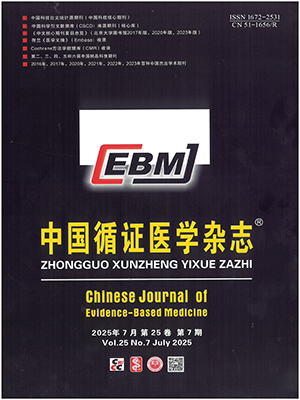| 1. |
Lee YS, Kim SY, Lee H, et al. ACURATE: a guide for reporting sham controls in trials using acupuncture. J Evid Based Med, 2023, 16(1): 82-90.
|
| 2. |
Ma P, Liu X, Liu Z, et al. The SHARE: SHam Acupuncture REporting guidelines and a checklist in clinical trials. J Evid Based Med, 2023, 16(4): 428-431.
|
| 3. |
Shi GX, Yang XM, Liu CZ, et al. Factors contributing to therapeutic effects evaluated in acupuncture clinical trials. Trials, 2012, 13: 42.
|
| 4. |
杨海永, 王东岩, 董旭, 等. 针刺研究中安慰针刺对照的研究现状. 中国针灸, 2020, 40(3): 337-341.
|
| 5. |
孙俊俊, 李云芬, 朱勉生. 针灸临床试验中安慰针刺对照的应用现状. 世界中医药, 2019, 14(8): 1959-1962, 1968.
|
| 6. |
黄梅芳, 俞昌德. 介绍国外针灸临床研究中几种安慰对照方法. 中国针灸, 2003, (10): 25-27.
|
| 7. |
Lee B, Kwon CY, Lee HW, et al. The effect of sham acupuncture can differ depending on the points needled in knee osteoarthritis: a systematic review and network meta-analysis. Heliyon, 2024, 10(4): e25650.
|
| 8. |
Lee B, Kwon CY, Lee HW, et al. Different outcomes according to needling point location used in sham acupuncture for cancer-related pain: a systematic review and network meta-analysis. Cancers (Basel), 2023, 15(24): 5875.
|
| 9. |
Lee B, Kim TH, Birch S, et al. Comparative effectiveness of acupuncture in sham-controlled trials for knee osteoarthritis: a systematic review and network meta-analysis. Front Med (Lausanne), 2023, 9: 1061878.
|
| 10. |
Lee YS, Kim SY, Kim M, et al. Reporting quality of sham needles used as controls in acupuncture trials: a methodological evaluation. Chin Med, 2022, 17(1): 64.
|
| 11. |
Xie Y, Liu X, Liu T, et al. Descriptions of sham acupuncture in randomised controlled trials: a critical review of the literature. BMC Complement Med Ther, 2023, 23(1): 173.
|
| 12. |
刘晓玉, 闫世艳, 郭义, 等. 针刺临床研究中模拟针刺对照报告相关指南比较分析. 针刺研究, 2022, 47(11): 1031-1035.
|
| 13. |
Li X, Wang T, Shi W, et al. Reporting guidelines for traditional Chinese medicine could be improved: a cross-sectional study. J Clin Epidemiol, 2024, 168: 111279.
|
| 14. |
李仲贤, 徐海燕, 阎路达, 等. 基于CONSORT声明、STRICTA标准、SHARE清单的针刺治疗抑郁症随机对照试验报告质量评价. 中国针灸, 2024, 44(8): 966-974.
|
| 15. |
Zheng X, Ji R, Li C, et al. Efficacy of electro-acupuncture on pregnancy outcomes for women undergoing in vitro fertilization: study protocol for a pilot randomized controlled trial. Front Endocrinol (Lausanne), 2024, 15: 1380885.
|
| 16. |
刘晓玉, 马培宏, 刘保延, 等. 针刺临床试验中假针刺对照报告指南与清单(SHARE)解读. 中国循证医学杂志, 2024, 24(7): 838-844.
|
| 17. |
Lee YS, Kim SY, Lee H, et al. ACURATE: a guide for reporting sham controls in trials using acupuncture. Integr Med Res, 2023, 12(2): 100955.
|
| 18. |
Lee YS, Kim SY, Lee H, et al. ACURATE: a guide for reporting sham controls in trials using acupuncture. J Acupunct Meridian Stud, 2023, 16(3): 119-126.
|
| 19. |
Lee YS, Kim SY, Lee H, et al. ACURATE: a guide for reporting sham controls in trials using acupuncture. Perspect Integr Med, 2023, 2(2): 100-106.
|
| 20. |
刘晓玉, 马培宏, 刘志顺, 等. 针刺临床试验中假针刺对照报告指南与清单(SHARE). 中国循证医学杂志, 2024, 24(7): 745-750.
|
| 21. |
Barnes K, Wang R, Faasse K. Practitioner warmth and empathy attenuates the nocebo effect and enhances the placebo effect. Appl Psychol Health Well Being, 2024, 16(2): 421-441.
|
| 22. |
Blasini M, Peiris N, Wright T, et al. The role of patient-practitioner relationships in placebo and nocebo phenomena. Int Rev Neurobiol, 2018, 139: 211-231.
|
| 23. |
Linde K, Witt CM, Streng A, et al. The impact of patient expectations on outcomes in four randomized controlled trials of acupuncture in patients with chronic pain. Pain, 2007, 128(3): 264-271.
|
| 24. |
Fei YT, Cao HJ, Xia RY, et al. Methodological challenges in design and conduct of randomised controlled trials in acupuncture. BMJ, 2022, 376: e064345.
|
| 25. |
Kaptchuk TJ, Kelley JM, Conboy LA, et al. Components of placebo effect: randomised controlled trial in patients with irritable bowel syndrome. BMJ, 2008, 336(7651): 999-1003.
|
| 26. |
Usichenko TI, Klausenitz C, Hesse T, et al. Effectiveness of acupuncture for pain control after Cesarean section is associated with the length of experience of the acupuncturist: observational data from a randomized clinical trial. Acupunct Med, 2022, 40(6): 556-558.
|
| 27. |
刘晓玉, 孙承颐, 孙重阳, 等. 外科安慰手术应用指南及其对针刺临床研究中假针刺应用的借鉴. 针刺研究, 2023, 48(4): 404-410.
|
| 28. |
Wu J, Chen B, Yin X, et al. Effect of acupuncture on post-hemorrhoidectomy pain: a randomized controlled trial. J Pain Res, 2018, 11: 1489-1496.
|
| 29. |
施兰君, 岗卫娟, 田紫煜, 等. 保真度及其在针灸临床研究中的应用与思考. 中国针灸, 2023, 43(7): 813-817.
|
| 30. |
Hollifield M, Hsiao AF, Smith T, et al. Acupuncture for combat-related posttraumatic stress disorder: a randomized clinical trial. JAMA Psychiatry, 2024, 81(6): 545-554.
|
| 31. |
Hollifield M, Hsiao AF, Carrick K, et al. Acupuncture for combat post-traumatic stress disorder: trial development and methodological approach for a randomized controlled clinical trial. Trials, 2021, 22(1): 594.
|
| 32. |
Cao HJ, Li X, Li XL, et al. Factors influencing participant compliance in acupuncture trials: an in-depth interview study. PLoS One, 2020, 15(4): e0231780.
|




